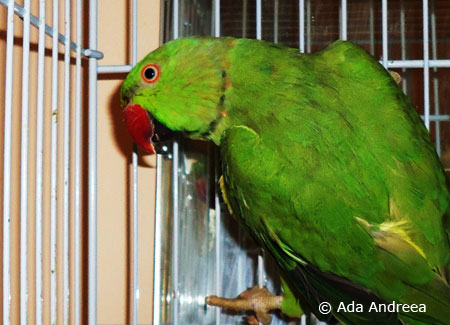Bird Help Center
Question:
ReTaming an Indian Ringneck
Hello! My baby boy Rico started to molt few weeks ago and 3-4 days earlier this week his ring started to show since you have experience, can you tell me approx how old is he? I bought him in 2012 and the seller said he is 6 months, but I don't know if to trust him or not. He is very wild..do you have some advice on how to tame him? I let him to fly free in the room but when I try to get close to him he's starting to shake, you can see how scared he is he had a period last year when he used to sit on me(without allowing me to touch him), but I went in vacation for 2 weeks and when I came home he was wild again. I would really appreciate some advices from an expert like you! Thank you a lot!

Answer:
Hello Ada Andreea,
First of all let me congratulate you on your pet ringneck attaining his
ring. Speaking from experience, when my ringneck got his ring I was
ecstatic. From the looks of your picture it seems your ringneck is very
young. In fact, if I were to guess his age I would say he is around 18
months. Most male Indian Ringnecks will start to develop their rings
around 18 months; however, some may take as long as three years.
As far as training is concerned, I'd say you're in for a fun journey.
When beginning the taming process it is important you know every parrot
is different. They all have their own personalities and all perceive the
world differently. Though I am not physically there to see why your
ringneck shakes, I would take a few steps back and see if anything is
scaring him inside the room. On another note, you should know that all
birds shake slightly as they have fast metabolisms. Use your best
judgment when evaluating his shaking behavior. Obviously, if you feel
the bird is ill take him to go see an avian veterinarian.
From your description it sounds as if your ringneck has "gone wild" as
they say. This happens when a ringneck is left alone during its younger
years for a time period. Don't worry though, all can be returned back to
normal.
As for taming, it's important you start a positive reinforcement program
to start the process all over again. Once the bird becomes tame he
should maintain his tameness. This tends to be a phenomena with younger
ringnecks--it usually happens during the imprinting period.
Mine never become wild when I leave for long trips. They are happy
creatures that get very excited to see me when I come home. Especially
my female ringneck Devri.
So you must be thinking what is positive reinforcement training anyway?
Basically, it's a technique used to tame the bird through positive
interactions. Over time this training method helps mold the bird into a
wonderful and loving pet.
Here is an
article I wrote previously on the subject. Check it out and
read it over. It should help you to get going on the taming process and
explain how this taming method works.
The very first thing that should be learned is targeting. The bird
should be trained to touch the tip of a target, usually the tip of the
small stick, and rewarded for the behavior. Once the bird has mastered
this it is important you coax the bird to stand on your hand by
targeting the bird towards it. This should be continued and practiced
over and over until the bird feels confident. Once the bird is very
secure you can move to more complex tasks such as waving, turning
around, or other tricks.
Every bird progresses at its own pace. Some are willing to pick up
behaviors quickly while others are slower to learn. Whatever the case,
it's important you stay consistent and loving while earning his trust.
If the bird should bite be sure to ignore it and progress with the
training session as if nothing has happened.
Find treats he is willing to work with. Mine love sliced apple. If I
make a big deal about something I'm eating, you bet my birds want in on
it! They really are funny little creatures.
Wishing you all the best! IMRAN-C




